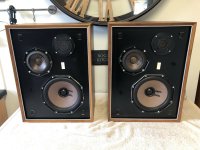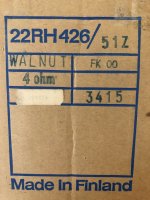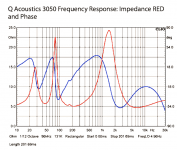Hi,
I've recently acquired a pair of Philips 22RH 426/51Z speakers, from the early '70's I think.
Not much info. about them online, although I did manage to find the service manual. The pdf is too big to attach, but can be found here:
Philips manuals | Hifi Manuals Free: page 13
I'm fairly certain they were never the best speakers available, but they're well made in a charming old school way, and a look inside reveals decent quality components in the crossover.
Any thoughts on what I should do with them?
Thanks,
Matt.
I've recently acquired a pair of Philips 22RH 426/51Z speakers, from the early '70's I think.
Not much info. about them online, although I did manage to find the service manual. The pdf is too big to attach, but can be found here:
Philips manuals | Hifi Manuals Free: page 13
I'm fairly certain they were never the best speakers available, but they're well made in a charming old school way, and a look inside reveals decent quality components in the crossover.
Any thoughts on what I should do with them?
Thanks,
Matt.
Here's a direct link to the Service Manual:
https://webspace.science.uu.nl/~tel00101/FotoAlbum/RadioCorner/Docu/Phil22rh426.pdf
How do they sound?
https://webspace.science.uu.nl/~tel00101/FotoAlbum/RadioCorner/Docu/Phil22rh426.pdf
How do they sound?
Last edited:
I'm not sure what alternatives you are considering.Any thoughts on what I should do with them?
To put their quality into a monetary perspective, the speakers cost 600 guilders in 1973, which would have a purchasing power of around 1,000 euros today. 😎
I'm fairly certain they were never the best speakers available, but they're well made in a charming old school way, and a look inside reveals decent quality components in the crossover.
I have not seen that speaker but i have used all those drivers and the XOs Philips supplied for use with them.
The drivers can be massaged, the tweeters likely the weakest bit (i probably have a dozen of them on the shelf for give-away), except for the XO which really sucks.
Can you post a pic of the XO in yours?
dave
Thanx Galu, from that manual we are talking about the same XO. Other than easy driver mods, andmaking sure th abox has some bracing (looks like some is badly needed), that is what i would first attack.
dave
dave
Any thoughts on what I should do with them?
Well, first find out how rare they actually are. If found to be very very rare, have them cleaned up (varnish/veneer) and reviewed by someone popular (like BBC). Now that should be the "top gear of speakers". You could then sell them citing the same, for a much, much higher price than before.
I like to see pictures of vintage speakers, and the attached could actually be of the ones you've acquired, as they were recently sold at auction!
Hi Galu,
I'll post some pics of the speakers tomorrow. They need a going over with a damp cloth and a polish, but aside from some light scratches and a few splashes of paint they're in good nick overall.
They were a gift from a friend, so they're not the ones which sold recently. They were her fathers, and as far as we know he bought them new back in the day.
I'm considering a couple of options - either to use them with my main amp/turntable in the living room, or to put together a secondary hi-fi setup in the attic.
My main amp is a diy EL84 based SET, putting out around 4W per channel. That was originally paired with an old set of Mission 752 Freedom's, which was not a good mix but at the time the only speakers I owned. Another friend took pity and lent me his spare Q Acoustic 3050's, which are a marked improvement, but still not the best match for my somewhat underpowered amp.
I don't know a great deal about speakers, but I'd hoped these might be a better match for the SET amp. The 8" woofer looks promising, at the very least...
If I go down the spare hi-fi in the attic route, I'd probably pair them with my old NAD tape deck and a period solid state amp, aiming for a 'lo-fi but musically appealing' vibe - something with no top end and more hiss than a bag of snakes 🙂
I plugged them in this afternoon, they sounded fine if not spectacular. I didn't push them too hard though, partly because they haven't been used in a decade or more, partly because my SET is hardwired for 8ohms and the speakers are rated at 4. The OT's are Hammonds and can likely take the pace, but better safe than sorry!
Pictures to follow,
Matt.
I have not seen that speaker but i have used all those drivers and the XOs Philips supplied for use with them.
The drivers can be massaged, the tweeters likely the weakest bit (i probably have a dozen of them on the shelf for give-away), except for the XO which really sucks.
Can you post a pic of the XO in yours?
dave
Hi Dave,
I'll post some pics of the XO tomorrow, time permitting. I thought they looked ok but I suppose the quality of parts won't make much difference if the circuit sucks! Alternatively, I may just be easily impressed...
You say the drivers can be 'massaged', could you explain that please?
Thanks,
Matt.
Well, first find out how rare they actually are. If found to be very very rare, have them cleaned up (varnish/veneer) and reviewed by someone popular (like BBC). Now that should be the "top gear of speakers". You could then sell them citing the same, for a much, much higher price than before.
If all else fails, I shall give that a try...😉
… the drivers can be 'massaged', could you explain that please?
There are lots of little easy (and more or less reversible tricks) but the really potent ones are not. I’d say the most important is to put a coat of plastic on the woofer — they midrange is usually done at the factory — in this case something like slightly thinned ModPodge is the ticket.
On the question of vintag evalue, Philips sold zillions of these and similar, they are not special in the vintage market i would think. So if you are not worried about that, new baffles with better driver placement would suggest itself.
The XOs are generic. More or less textbook with either 4 or 8Ω impedance. One should be able to dramatically improve them, that takes some work.
I’d consider tossing/flogging the mid & tweeter, run a 4” PVC pipe out the back and mount a good 3” midTweeter. And biamp.
Your EL84 SE will be sensitive the real impedance curve of whatever you connect it to. Speakers with XOs rarely concern themselves too much about flattness of impedance. Your Q do not look to be a good fit to your little SE.
dave
Attachments
Correct, the boxed pair I illustrated sold recently for £43.On the question of vintag evalue, Philips sold zillions of these and similar, they are not special in the vintage market i would think.
There are lots of little easy (and more or less reversible tricks) but the really potent ones are not. I’d say the most important is to put a coat of plastic on the woofer — they midrange is usually done at the factory — in this case something like slightly thinned ModPodge is the ticket.
On the question of vintag evalue, Philips sold zillions of these and similar, they are not special in the vintage market i would think. So if you are not worried about that, new baffles with better driver placement would suggest itself.
The XOs are generic. More or less textbook with either 4 or 8Ω impedance. One should be able to dramatically improve them, that takes some work.
I’d consider tossing/flogging the mid & tweeter, run a 4” PVC pipe out the back and mount a good 3” midTweeter. And biamp.
Your EL84 SE will be sensitive the real impedance curve of whatever you connect it to. Speakers with XOs rarely concern themselves too much about flattness of impedance. Your Q do not look to be a good fit to your little SE.
dave
Thanks for the info. So for 'massage', read 'improve'. Gotcha 🙂
The Q's are not a good match for my SET, but they are better than the Missions. Not an amazing feat, but a (small) step in the right direction - plus as I said, they cost me nothing.
Do you think the Philips speakers have any potential to be a better match? I'm not worried about vintage value (if they're no good for hi-fi, I'll make a pair of matching guitar amps), but I'm willing to sink some time and money into them if it'll be worth it.
On a different note, what speaker would you idealy recommend for a SET? I'm planning an overhaul that'll up the output to around 10W per channel. On paper, at least 🙂
Thanks,
Matt.
Do you think the Philips speakers have any potential to be a better match?
Not really. Hence my suggestion of subbing in a midTweeter for the mid & tweeter and add an amp for the bottom (doesn’t need to be pricey), and biamp. I’d start with a simple PLLXO.
dave
Photos...
Hi all,
As promised, some photos of the speakers:
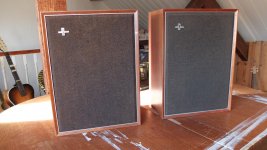
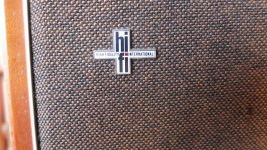
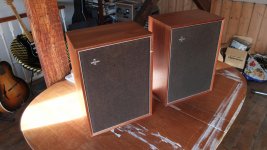
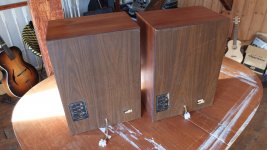
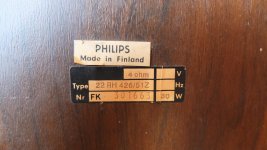
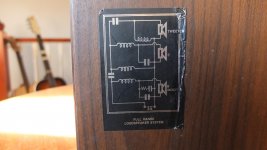
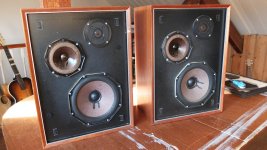
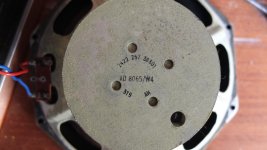
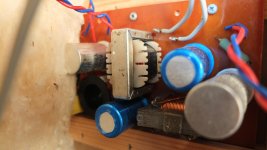
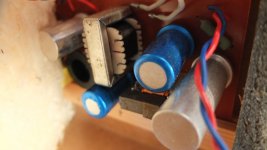
Not in bad condition for their age, and they look quite good in the wood-panelled surroundings of our attic. Given that they're probably a non-starter for the main hi-fi downstairs, a second system up here beckons...
Do the codes on the woofer tell us anything more about their quality/provenance?
#planet10 - I took some shots of the XO's for you, although at this point I assume they'll only confirm your suspicions that they're rubbish. I thought the component quality looked ok, but I'm no expert. Plus as I said before, quality parts in a crap circuit aren't going to save the day 🙂
Hi all,
As promised, some photos of the speakers:










Not in bad condition for their age, and they look quite good in the wood-panelled surroundings of our attic. Given that they're probably a non-starter for the main hi-fi downstairs, a second system up here beckons...
Do the codes on the woofer tell us anything more about their quality/provenance?
#planet10 - I took some shots of the XO's for you, although at this point I assume they'll only confirm your suspicions that they're rubbish. I thought the component quality looked ok, but I'm no expert. Plus as I said before, quality parts in a crap circuit aren't going to save the day 🙂
There are lots of little easy (and more or less reversible tricks) but the really potent ones are not. I’d say the most important is to put a coat of plastic on the woofer — they midrange is usually done at the factory — in this case something like slightly thinned ModPodge is the ticket.
dave
Hi Dave,
I'll try not to trouble you again after this, but could you explain a little more about the benefits of applying a coat of plastic to the woofer, or point me in the direction of a thread/website/etc which can?
Many thanks for your input,
Matt.
Yes those are the XOs. Besides being generic, you have ancient Elco cas and iron core inductors.
The coat of modPodge on the cone ties the surface paper fibres into place sreducing the cone self-noise and giving it the ability to not have the small stuff buried in the noise as much. It can make a fairly dramatic differences.
Speaker Tweeks -- Puzzlecoat & Ductseal
Those are the standard 8”. We used a lot of the 8Ω version.
dave
The coat of modPodge on the cone ties the surface paper fibres into place sreducing the cone self-noise and giving it the ability to not have the small stuff buried in the noise as much. It can make a fairly dramatic differences.
Speaker Tweeks -- Puzzlecoat & Ductseal
Those are the standard 8”. We used a lot of the 8Ω version.
dave
That would seem a reasonable use for these handsome, retro look speakers.a second system up here beckons...
I probably wouldn't do much more than replace the bipolar electrolytic capacitors with modern equivalents. Simply choose the current standard uF values closest to the ones in your crossover. In this simple crossover, a small difference in absolute capacitor values will be outweighed by the use of fresher capacitors.
Here's a handy source of replacement capacitors: Mundorf Electrolytic ECap Capacitors
Hi Dave,Yes those are the XOs. Besides being generic, you have ancient Elco cas and iron core inductors.
The coat of modPodge on the cone ties the surface paper fibres into place sreducing the cone self-noise and giving it the ability to not have the small stuff buried in the noise as much. It can make a fairly dramatic differences.
Speaker Tweeks -- Puzzlecoat & Ductseal
Those are the standard 8”. We used a lot of the 8Ω version.
dave
Thanks for your help. I've all manner of PVA glues at my workshop - I expect one of them will fit the bill. I've an old pair of Sony bookshelf speakers waiting to go to the tip - I'll try coating them first to get a feel for it.
Matt.
That would seem a reasonable use for these handsome, retro look speakers.
I probably wouldn't do much more than replace the bipolar electrolytic capacitors with modern equivalents. Simply choose the current standard uF values closest to the ones in your crossover. In this simple crossover, a small difference in absolute capacitor values will be outweighed by the use of fresher capacitors.
Here's a handy source of replacement capacitors: Mundorf Electrolytic ECap Capacitors
Hi Galu,
Good point regarding the ancient electrolytic caps, it hadn't occurred to me to replace them (although it should have - I've replaced enough over the years!). I've a fairly decent stash of spares, hopefully I'll turn up the correct values.
That's this afternoons project taken care of... 🙂
Thanks,
Matt.
- Home
- Loudspeakers
- Multi-Way
- Philips 22RH 426 Full Range Speakers...
